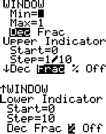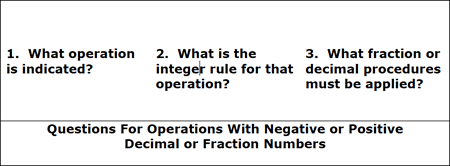Ordering and Computing With Negative Fractions and Deci
Main Core Tie
Mathematics Grade 7
Strand: THE NUMBER SYSTEM (7.NS) Standard 7.NS.1
Summary
Order negative numbers. Compute using negative fractions and decimals.
Materials
Attachments
- Small mirrors or CD jewel cases for reflecting a Numberline.
- Paper and scissors for foldable
- TI-73's
- Students need their Foldables from Sept Lesson 4 and October Lesson1 and 2
- 3x5 or 4x6 cards (cut up card stock works fine)
- Worksheet: Locating and Ordering Fraction and Decimal Numbers Using A Numberline
Background for Teachers
Enduring Understanding
(Big Ideas):
Between any two rational
numbers lies an infinite
number of rational numbers.
Fraction and decimal
computation.
Essential Questions:
- How is finding the approximate locations of rational numbers on the positive side of a number line similar or different from finding the locations of rational numbers on the negative side of a number line ?
- How can I apply the algorithms and rules for operating with positive rational numbers and integers when using negative fractions and decimals?
Skill Focus:
Find location of and compute
with negative fractions and
decimals
Vocabulary Focus:
Rational number, negative fraction, negative decimal
Ways to Gain/Maintain Attention (Primacy):
technology, writing, game
Instructional Procedures
Attachments
Starter: Review
Find the approximate location of each pair of numbers on a number line, and tell
which has the greater value of the two.
- 5, 3
- 0.25, 0.75
- 2/5 , 1/4
- -2, -5
Lesson Segment 1: How is finding the approximate locations of rational
numbers on the positive side of a number line similar and different from
finding the locations of rational numbers on the negative side of a number
line?
Review with students that when two numbers are in different forms, i.e. a
fraction and a decimal, writing them in the same form will allow us to compare them
more easily. See the foldable made during the Ordering and Comparing Rational
Numbers lesson for reviewing converting rational numbers to different forms.
Flap 1: Fraction to decimal: Divide numerator into denominator, or use ![]() on Ti-73.
on Ti-73.
Flap 2: Decimal to fraction: Write decimal as a fraction in 10ths, 100ths… or use ![]() on Ti-73.
on Ti-73.
Have student use Round Robin so each will share their preference with others for
this question:
Q. When you look for where a number is located on the number line, which form would
be easier for you to visualize, fraction or decimal?
Q. Why do you think so? (Often visualizing a fraction or part of a number line
segment is easier than visualizing a decimal on the number line.) Also, remind
students that rounding to half, fourths or tenths can help us locate a number.
Work with the class to complete the attached investigation worksheet, "Locating and Ordering Fraction and Decimal Numbers Using A Numberline", to compare locating positive fraction and decimal numbers with locating fraction and decimal numbers. A mirror (CD jewel case works for a mirror) can be very useful in helping students see the reflection across zero on a numberline thus visualizing what the negative side of the numberline should look like. If you are familiar with using the Numline App on the TI-73, you may want students to use that application to check their comparisons, or to give access to those students who are still struggling with computations.
Using the Numline APP To Compare Rational Numbers
You must have the Numline App downloaded on your calculator, if it is not preloaded.
Select ![]() . Choose Numline. In Numline, select Fraction line. Push
. Choose Numline. In Numline, select Fraction line. Push ![]() , and set
the window as shown below, except use -1or -10 as the Start value rather than 0..
, and set
the window as shown below, except use -1or -10 as the Start value rather than 0..
 After the window is set,
After the window is set, ![]()
![]() . The screen will look like
this:
. The screen will look like
this:
![]()
Use the up or down arrow keys to select the fraction (top)
or the percent (bottom) indicator. Using the right and left
arrow keys, you can move the indicators along the line to
find values in increments of tenths and of ten percent
intervals.
You may select a different minimum and maximum if
you want numbers greater than 1.
To show a specific rational number or compare several rational numbers using the
number line, push ![]() . Select DrawLabel. Type a rational number and push
. Select DrawLabel. Type a rational number and push ![]() .
Then type another rational number and push
.
Then type another rational number and push ![]() . You can compare several rational
numbers, percents, or ratios by looking at their distance from 0.
Lesson Segment 2: How can I apply the algorithms and rules for operating
with positive rational numbers and integers when using negative fractions and
decimals?
. You can compare several rational
numbers, percents, or ratios by looking at their distance from 0.
Lesson Segment 2: How can I apply the algorithms and rules for operating
with positive rational numbers and integers when using negative fractions and
decimals?
Ask students to review their journal notes for Computing With Fractions and for
Computing With Decimals from September Lesson 3. Then, ask them to review their
Foldable for Operations With Integers Rules from October Lesson 1 and 2 by reading
through the examples and notes. Tell them when computing with fraction or decimal
numbers, the procedures will be the same, BUT, they must apply the rules for working
with negative integers as well.
Use a Three-Flap Foldable to help them take notes on the procedures for operating.

Under the flaps, show these examples and have students write as they work the problems.
A. -0.4 + -2.25
B. - 1/2 x -1/4
The NumLine App can be used to check the addition and subtraction.
Work through several examples with the students using Board Talk Protocol to have them reason and explain to their peers. This protocol helps students listen to other's explanations, so they can learn from each other.
Board Talk Protocol
Two students are randomly selected to come to the board to individually sketch
and show their reasoning for the first problem. While the two students are working at
the board, the remaining students work in their seats to complete show their ideas for
that problem. The students at the board work in separate spaces on the board, so the
seated class members will be able to see and compare separate responses.
Teacher selects one student at the board to explain to the class what they have done.
The class is told they must each write one GOOD QUESTION about the explanation the
student at the board is giving. A good question starts with how, why, what if, or can
you clarify?… (Write these GOOD QUESTION starters on the board.) Students must
write their good question on their assignment paper as the student is explaining.
After the explaining student finishes, the teacher selects one or two from the class to ask their GOOD QUESTION to the explaining student. The teacher then asks the second student at the board to then explain their approach, especially if they have a different response. The seated students again write a GOOD QUESTION for that explaining student. Or, the teacher may ask the class members to look at both responses on the board and prepare to describe how they are similar or different. number to be the middle man. If they can convert a fraction to a decimal or a percent to a decimal first, they can easily convert to the other form.
Practice: Do Pass-Around-Problem where each team writes either a decimal or a fraction number operations problem using positive/negative signs on the front of a card. On the back of the card, the team shows how they will do the problem. The cards are then rotated to another team. The team looks at the problem, but not at the back where the work is shown. That team works to do the problem on their own papers, and then they compare with the back of the card.
Play Team Challenge Game:
Each team is given four cards with rational numbers (attached). Each team will
first plot each number on a number line. They will then choose any two of their
numbers and write a problem using one of the four operations. They work their
problem on their own assignment papers, and plot the answer on the number line.
Teacher selects a team member to come up and write their original numbers. The
challenger asks the class plot each of their numbers, then to work through the problem
their team has written. Students number the problems on their assignment page
according to the team number doing the challenging. The students get four minutes to
plot the numbers and to work the problem they have been challenged to do. They may
work with their team members to do this. The challenger then chooses any person in
the class to show and explain the problem on the overhead, or on a Smart Pa,l or Team
Board. If correct, that person's team gets a treat or points. If not, the challenger does
the problem for the class and the challenger's team gets the treat.
Assign text practice as needed.
Assessment Plan
performance tasks, observation
Bibliography
This lesson plan was created by Linda Bolin.
Updated: 02/04/2018


 UTAH EDUCATION NETWORK
UTAH EDUCATION NETWORK

 Justin
Justin Braxton
Braxton Dani
Dani Kayla
Kayla Katie
Katie Matthew
Matthew Rob
Rob Val
Val
